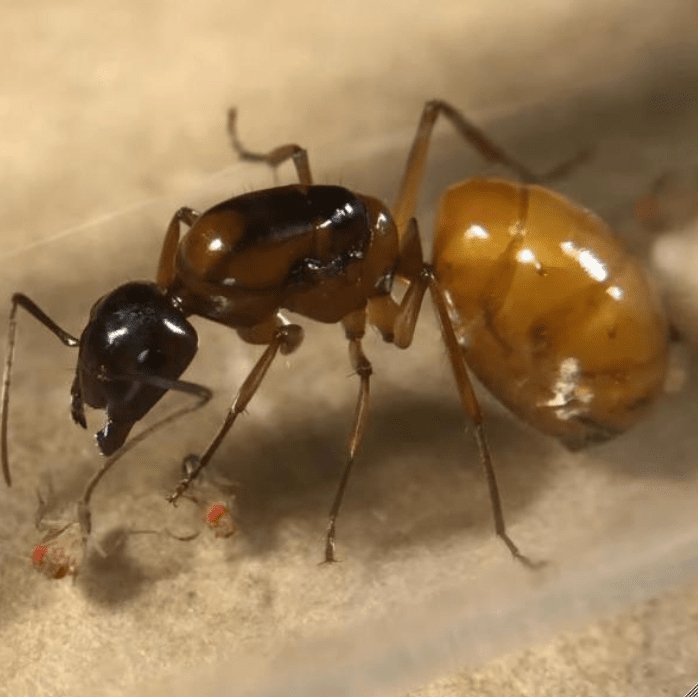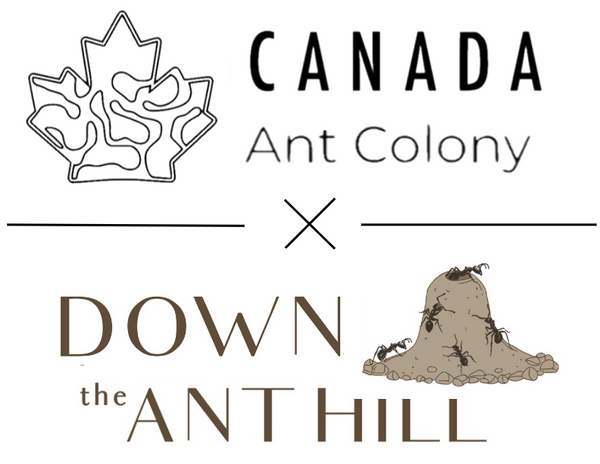Canada Ant Colony
Camponotus semitestaceus (Sunrise Carpenter Ant)
Camponotus semitestaceus (Sunrise Carpenter Ant)
Couldn't load pickup availability
The Sunrise Carpenter Ant, or Camponotus semitestaceus, is very varied. Although currently regarded as a single species, in the future it will probably be split up into a handful. They however do have shared traits that separate them from other Camponotus species. They're all large and nocturnal, with the typical diet of insects and sugary liquids. They have both small minor workers and large big-headed soldier ants. Their workers will hunt aggressively, with majors being capable of shredding small insects. All will nest in the ground. All of them are very pretty, stunning ants. None can sting, all of them are fun to keep.
Camponotus semitestaceus, all of its varieties, belong to the Tanaemyrmex subgenus. With workers ranging from 8 to 16mm, and queens ranging from 14-17mm, they can be tricky for beginners to separate from other Camponotus, but with a trained eye it can be done based largely on the shape of their antennae.
This species is an amazing pick for beginners. Though brood grow slowly due to their large size, their care is very simple, consisting of the usual sugar water and insect combination. They can be housed in basically any nest, though wood nests are not recommended. Hibernation is not required.
| Scientific Name: |
Camponotus semitestaceus
|
| Common Name: | Sunrise Carpenter Ant |
| Taxonomy: |
Kingdom: Animalia | Phylum: Arthropoda | Class: Insecta | Order: Hymenoptera | Family: Formicidae | Subfamily: Formicinae | Genus: Camponotus | Species: C. semitestaceus
|
| Care Difficulty: | Camponotus semitestaceus is a beginner level species. |
| Distribution: |
This species can only be found in western North America.
|
| Habitat: | More xerophilic habitats, from mixed chaparral to large deserts. |
| Colony form: | Largely monogynous, meaning only one queen in a single colony. There are however some polygynous (more than one queen in a colony) variants. |
| Queen: | Queens of this species reach a size of around 14-17mm. |
| Worker: | Majors will approach 16 mm, minors will stay around 8-9 mm, with medias being anywhere in between. |
| Nutrition: | The typical insect and sugar water combination is more than adequate for this species. |
| Air humidity: | Humidity should be greater than 35%. |
| Temperature: |
Heating will drastically decrease the time from egg to worker, and this species can be heated safely up to 32 Celsius.
|
| Hibernation: | Though diapause is not necessary for every variant of this species, due to how many do require it the safest course of option is to hibernate every colony, as it can't hurt them. |
| Nesting Habits: | In the wild they have been observed to nest directly in the dirt or under stones. |
| Kind of Formicaria: | Nearly any typical setup will work for them, including Tarheel Ants formicarium, other plaster nests, acrylic nests. Woods nests however cannot be recommended. |
| Formicaria size: | Colonies will get larger than 5,000 workers, but will both take a while to get there and not get to that size unless you feed them enough. |
| Description: |
Camponotus semitestaceus is a very large and aggressive ant. Though they may be very variable, all of them are pretty and fun to keep. |
| Development: | Colonies will mostly have their nuptial flights during late Spring to early Summer. Some will fly later however. |
| Offering quantity: | Queen, Queen + 5-10 workers, Queen + 10-25 workers, Queen + 25-50 workers, Queen + 50-100 workers. |
| Weblinks: |
Shipping Conditions
This species comes from more tropical areas than Canada, and are not cold-tolerant. Thus, we will not ship them in the winter
Just a warning, we will NOT ship live ants into the US unless the receiver has a permit. If such an order is made, it will be refunded, minus a 10% processing fee and restocking fee
This product is from Canada Ant Colony. The full catalogue, including all variants, can be found at https://canada-ant-colony.com
For US Ant Keepers
We can't ship live ants to the US, but we've partnered with Stateside Ants to help spread ant keeping. They're a highly reputable ant store and ship to all states in the lower 48. You can check them out here and use code DTAHAFFIL for 10% off
Share

- Description
- For US Ant Keepers
- Reviews
The Sunrise Carpenter Ant, or Camponotus semitestaceus, is very varied. Although currently regarded as a single species, in the future it will probably be split up into a handful. They however do have shared traits that separate them from other Camponotus species. They're all large and nocturnal, with the typical diet of insects and sugary liquids. They have both small minor workers and large big-headed soldier ants. Their workers will hunt aggressively, with majors being capable of shredding small insects. All will nest in the ground. All of them are very pretty, stunning ants. None can sting, all of them are fun to keep.
Camponotus semitestaceus, all of its varieties, belong to the Tanaemyrmex subgenus. With workers ranging from 8 to 16mm, and queens ranging from 14-17mm, they can be tricky for beginners to separate from other Camponotus, but with a trained eye it can be done based largely on the shape of their antennae.
This species is an amazing pick for beginners. Though brood grow slowly due to their large size, their care is very simple, consisting of the usual sugar water and insect combination. They can be housed in basically any nest, though wood nests are not recommended. Hibernation is not required.
| Scientific Name: | Camponotus semitestaceus |
| Common Name: | Sunrise Carpenter Ant |
| Taxonomy: | Kingdom: Animalia | Phylum: Arthropoda | Class: Insecta | Order: Hymenoptera | Family: Formicidae | Subfamily: Formicinae | Genus: Camponotus | Species: C. semitestaceus |
| Care Difficulty: | Camponotus semitestaceus is a beginner level species. |
| Distribution: | This species can only be found in western North America. |
| Habitat: | More xerophilic habitats, from mixed chaparral to large deserts. |
| Colony form: | Largely monogynous, meaning only one queen in a single colony. There are however some polygynous (more than one queen in a colony) variants. |
| Queen: | Queens of this species reach a size of around 14-17mm. |
| Worker: | Majors will approach 16 mm, minors will stay around 8-9 mm, with medias being anywhere in between. |
| Nutrition: | The typical insect and sugar water combination is more than adequate for this species. |
| Air humidity: | Humidity should be greater than 35%. |
| Temperature: | Heating will drastically decrease the time from egg to worker, and this species can be heated safely up to 32 Celsius. |
| Hibernation: | Though diapause is not necessary for every variant of this species, due to how many do require it the safest course of option is to hibernate every colony, as it can't hurt them. |
| Nesting Habits: | In the wild they have been observed to nest directly in the dirt or under stones. |
| Kind of Formicaria: | Nearly any typical setup will work for them, including Tarheel Ants formicarium, other plaster nests, acrylic nests. Woods nests however cannot be recommended. |
| Formicaria size: | Colonies will get larger than 5,000 workers, but will both take a while to get there and not get to that size unless you feed them enough. |
| Description: |
Camponotus semitestaceus is a very large and aggressive ant. Though they may be very variable, all of them are pretty and fun to keep. |
| Development: | Colonies will mostly have their nuptial flights during late Spring to early Summer. Some will fly later however. |
| Offering quantity: | Queen, Queen + 5-10 workers, Queen + 10-25 workers, Queen + 25-50 workers, Queen + 50-100 workers. |
| Weblinks: | https://www.antwiki.org/wiki/Camponotus_semitestaceus |
Shipping Conditions
This species comes from more tropical areas than Canada, and are not cold-tolerant. Thus, we will not ship them in the winter
Just a warning, we will NOT ship live ants into the US unless the receiver has a permit. If such an order is made, it will be refunded, minus a 10% processing fee and restocking fee
This product is from Canada Ant Colony. The full catalogue, including all variants, can be found at https://canada-ant-colony.com
We can't ship live ants to the US, but we've partnered with Stateside Ants to help spread ant keeping. They're a highly reputable ant store and ship to all states in the lower 48. You can check them out here and use code DTAHAFFIL for 10% off

